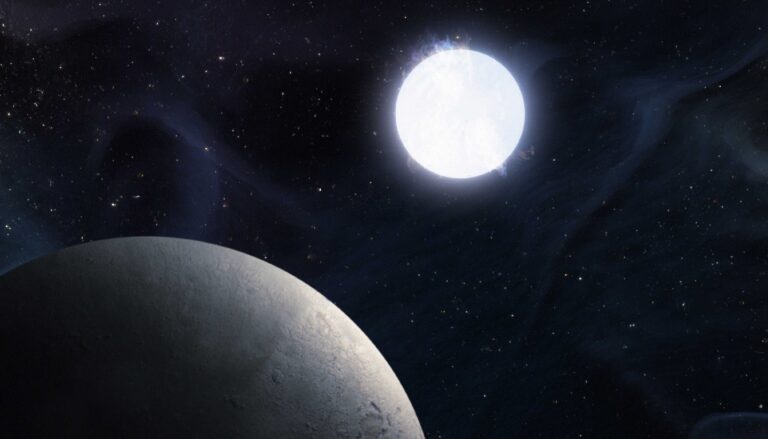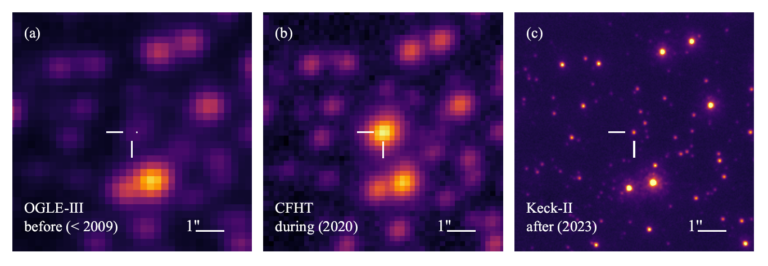Rocky Planet Around a White Dwarf Resembles Earth 8 Billion Years From Now
Existence of Earth-like planet around dead sun offers hope for our planet's ultimate survival

The discovery of an Earth-like planet 4,000 light years away in the Milky Way galaxy provides a preview of one possible fate for our planet billions of years in the future, when the sun has turned into a white dwarf, and a blasted and frozen Earth has migrated beyond the orbit of Mars.
This distant planetary system, identified by University of California, Berkeley, astronomers after observations with the Keck 10-meter telescope in Hawaii, looks very similar to expectations for the sun-Earth system: it consists of a white dwarf about half the mass of the sun and an Earth-size companion in an orbit twice as large as Earth’s today.
That is likely to be Earth’s fate. The sun will eventually inflate like a balloon larger than Earth’s orbit today, engulfing Mercury and Venus in the process. As the star expands to become a red giant, its decreasing mass will force planets to migrate to more distant orbits, offering Earth a slim opportunity to survive farther from the sun. Eventually, the outer layers of the red giant will be blown away to leave behind a dense white dwarf no larger than a planet, but with the mass of a star. If Earth has survived by then, it will probably end up in an orbit twice its current size.
The discovery, to be published this week in the journal Nature Astronomy, tells scientists about the evolution of main sequence stars, like the sun, through the red giant phase to a white dwarf, and how it affects the planets around them. Some studies suggest that for the sun, this process could begin in about 1 billion years, eventually vaporizing Earth’s oceans and doubling Earth’s orbital radius — if the expanding star doesn’t engulf our planet first.
Eventually, about 8 billion years from now, the sun’s outer layers will have dispersed to leave behind a dense, glowing ball — a white dwarf — that is about half the mass of the sun, but smaller in size than Earth.
“We do not currently have a consensus whether Earth could avoid being engulfed by the red giant sun in 6 billion years,” said study leader Keming Zhang, a former doctoral student at the University of California, Berkeley, who is now an Eric and Wendy Schmidt AI in Science Postdoctoral fellow at UC San Diego. “In any case, planet Earth will only be habitable for around another billion years, at which point Earth’s oceans would be vaporized by runaway greenhouse effect — long before the risk of getting swallowed by the red giant.”
The planetary system provides one example of a planet that did survive, though it is far outside the habitable zone of the dim white dwarf and unlikely to harbor life. It may have had habitable conditions at some point, when its host was still a sun-like star.
“Whether life can survive on Earth through that (red giant) period is unknown. But certainly the most important thing is that Earth isn’t swallowed by the sun when it becomes a red giant,” said Jessica Lu, associate professor and chair of astronomy at UC Berkeley. “This system that Keming’s found is an example of a planet — probably an Earth-like planet originally on a similar orbit to Earth — that survived its host star’s red giant phase.”
Microlensing makes star brighten a thousandfold
The far-away planetary system, located near the bulge at the center of our galaxy, came to astronomers’ attention in 2020 when it passed in front of a more distant star and magnified that star’s light by a factor of 1,000. The gravity of the system acted like a lens to focus and amplify the light from the background star.

The team that discovered this “microlensing event” dubbed it KMT-2020-BLG-0414 because it was detected by the Korea Microlensing Telescope Network in the Southern Hemisphere. The magnification of the background star — also in the Milky Way, but about 25,000 light years from Earth — was still only a pinprick of light. Nevertheless, its variation in intensity over about two months allowed the team to estimate that the system included a star about half the mass of the sun, a planet about the mass of Earth and a very large planet about 17 times the mass of Jupiter — likely a brown dwarf. Brown dwarfs are failed stars, with a mass just shy of that required to ignite fusion in the core.
The analysis also concluded that the Earth-like planet was between 1 and 2 astronomical units from the star — that is, about twice the distance between the Earth and sun. It was unclear what kind of star the host was because its light was lost in the glare of the magnified background star and a few nearby stars.
To identify the type of star, Zhang and his colleagues, including UC Berkeley astronomers Jessica Lu and Joshua Bloom, looked more closely at the lensing system in 2023 using the Keck II 10-meter telescope in Hawaii, which is outfitted with adaptive optics to eliminate blur from the atmosphere. Because they observed the system three years after the lensing event, the background star that had once been magnified 1,000 times had become faint enough that the lensing star should have been visible if it was a typical main-sequence star like the sun, Lu said.
But Zhang detected nothing in two separate Keck images.
“Our conclusions are based on ruling out the alternative scenarios, since a normal star would have been easily seen,” Zhang said. “Because the lens is both dark and low mass, we concluded that it can only be a white dwarf.”
“This is a case of where seeing nothing is actually more interesting than seeing something,” said Lu, who looks for microlensing events caused by free-floating stellar-mass black holes in the Milky Way.
Finding exoplanets through microlensing
The discovery is part of a project by Zhang to more closely study microlensing events that show the presence of a planet, in order to understand what types of stars exoplanets live around.
“There is some luck involved, because you’d expect fewer than one in 10 microlensing stars with planets to be white dwarfs,” Zhang said.
The new observations also allowed Zhang and colleagues to resolve an ambiguity regarding the location of the brown dwarf.
“The original analysis showed that the brown dwarf is either in a very wide orbit, like Neptune’s, or well within Mercury’s orbit. Giant planets on very small orbits are actually quite common outside the solar system,” Zhang said, referring to a class of planets called hot Jupiters. “But since we now know it is orbiting a stellar remnant, this is unlikely, as it would have been engulfed.”
The modeling ambiguity is caused by so-called microlensing degeneracy, where two distinct lensing configurations can give rise to the same lensing effect. This degeneracy is related to the one Zhang and Bloom discovered in 2022 using an AI method to analyze microlensing simulations. Zhang also applied the same AI technique to rule out alternative models for KMT-2020-BLG-0414 that may have been missed.
“Microlensing has turned into a very interesting way of studying other star systems that can’t be observed and detected by the conventional means, i.e. the transit method or the radial velocity method,” Bloom said. “There is a whole set of worlds that are now opening up to us through the microlensing channel, and what’s exciting is that we’re on the precipice of finding exotic configurations like this.”
One purpose of NASA’s Nancy Grace Roman Telescope, scheduled for launch in 2027, is to measure light curves from microlensing events to find exoplanets, many of which will need follow up using other telescopes to identify the types of stars hosting the exoplanets.
“What is required is careful follow up with the world’s best facilities, i.e. adaptive optics and the Keck Observatory, not just a day or a month later, but many, many years into the future, after the lens has moved away from the background star so you can start disambiguating what you’re seeing,” Bloom said.
Zhang noted that even if Earth gets engulfed during the sun’s red giant phase in a billion or so years, humanity may find a refuge in the outer solar system. Several moons of Jupiter, such as Europa, Callisto and Ganymede, and Enceladus around Saturn, appear to have frozen water oceans that will likely thaw as the outer layers of the red giant expand.
“As the sun becomes a red giant, the habitable zone will move to around Jupiter and Saturn’s orbit, and many of these moons will become ocean planets,” Zhang said. “I think, in that case, humanity could migrate out there.”
Other co-authors are Weicheng Zang and Shude Mao of Tsinghua University in Beijing, China, who co-authored the first paper about KMT-2020-BLG-0414; former UC Berkeley doctoral student Kareem El-Badry, now an assistant professor at the California Institute of Technology in Pasadena; Eric Agol of the University of Washington in Seattle; B. Scott Gaudi of The Ohio State University in Columbus; Quinn Konopacky of UC San Diego; Natalie LeBaron of UC Berkeley; and Sean Terry of the University of Maryland in College Park.
RELATED INFORMATION
